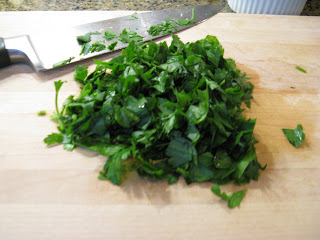Tonight's dinner is one of those meals, which in my house we just call "Tuna Pasta". I originally got the recipe from the excellent Essentials of Classic Italian Cooking, by Marcella Hazan. If you don't own this book, you should. The pasta section alone is worth the book, but everything in it is great.
Tuna Pasta is penne pasta with a simple tuna and tomato sauce. It sounds basic, and it is, but the flavors (garlic, tuna, tomatoes, parsley, salt and pepper) work so well together that it's just perfection. In the time that you can make something like spaghetti from a jar (if you count the pasta time) or tuna helper, you can have something really good.
Tuna Pasta:
1 lb penne pasta
4 tbsp olive oil
1-2 tbsp minced garlic
1 15oz can diced tomatoes
1 tbsp butter
2 cans olive-oil packed tuna, drained and flaked
chopped parsley to taste (I like 3-4 tbsp or more)
salt (coarse kosher!) and pepper
Begin boiling water for pasta. Heat olive oil over med/med-lo heat, and add garlic. Cook until golden and fragrant but not brown. Add tomatoes (with juice) and bring to a simmer.
When water boils, add pasta. A few minutes before the pasta is done, take tomatoes off heat, and add butter, stirring to melt. Add tuna, and combine. When pasta's done, drain and return to pot. Add sauce, and stir to combine. Add chopped parsley, fresh ground pepper and salt, and stir again. Serve.
Now that's a simple dinner, but again, it's really good, and it works perfectly when you're worn out from a day of working for the man, and you just want to get dinner on the table.
With respect to the parsley, I use italian flat leaf since I think it tastes better and has a better mouth-feel, but you can use the curly kind. The curly kind can have more sand in its nooks and crannies, so you probably need to wash it a bit more than italian, but if you wash it like you'd do spinach, you should be ok.
You may be tempted to substitute either vegetable oil packed tuna or water packed tuna. If you must (and you really shouldn't, since the tuna is the focal point of the whole shebang, and so you should get the best you can), go for the water packed over the vegetable oil packed tuna. The veg oil tuna is a little cat-foody in texture, if you ask me.
Some pics:





Finally, if you've made it this far, apologies for the lame pun in the title. It was either that or "you can tuna piano...", but I figured that one had been done to death.

.jpg)